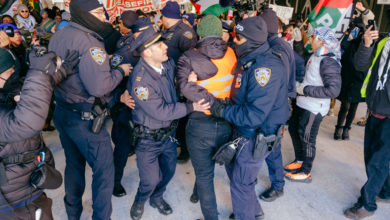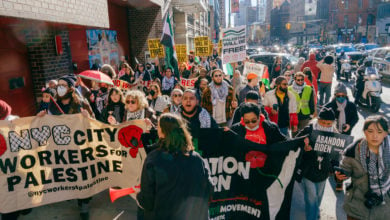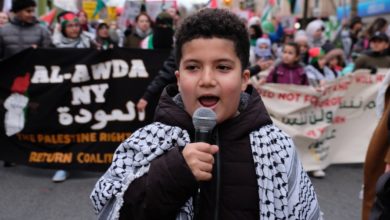The high level of militancy and self-confidence demonstrated by the protesters throughout the night cannot be overstated.
At Union Square, where most of the demonstrations originated, there were hundreds of NYPD officers and dozens of NYPD mounted units assembled nearby. Many police and news helicopters combed the sky of lower Manhattan.
The various marches around the city were long, loud and energetic — truly people’s-led marches that lasted until nearly 2:30am Wednesday morning. Each went to different major intersections throughout the city, staging moments of silence and sit-downs like in Brooklyn at the Barclays Center, the United Nations building in midtown Manhattan and in front of the state building in Harlem.
Both major highways in Manhattan, the FDR Drive and West Side Highway were taken over by militant protesters.
The Manhattan Bridge was shut down for nearly an hour as marchers walked against oncoming traffic. Many of the drivers chanted along with the protesters and honked their car horns in solidarity.
One march took thousands of people through the Jacob Riis projects in the Lower East Side, a community dealing with some of the highest levels of gentrification and police presence. The chants for Mike Brown echoed throughout the housing projects and dozens of youth from the projects jumped into the march.
Chris Gonzalez, a 14-year-old said “I heard the march from my 10th floor apartment and told my grandma that I would be back in a few hours. I have to go stand up for Mike Brown!”
Notably, many protesters brought along their children, ranging from toddlers in carriers to grade schoolers. Dari Rodriguez, mother of two grade-school boys, said “I knew I had to be here but I am so glad I took my kids, I am so proud to be a mami of kids who used their little feet, hands and voices to rally tonight for justice!” Many Black and Latino parents expressed that they feared for their children’s safety in daily interactions with the police.
It was apparent throughout that the NYPD had orders to generally not carry out their usual violence and mass arrests. Initial attempts to deter protesters from taking over bridges and highways usually ended with police conceding to the powerful momentum and energy of the crowd.
Earlier in the day NYPD Commissioner William Bratton said the police would be giving protesters “breathing room.” Their hope is that this will defuse the movement so that it does not follow Ferguson’s militant leadership.
Mayor De Blasio is trying to put distance between the case of Mike Brown and the recent NYPD murders of Eric Garner, Kimani Gray and Akai Gurley by saying, “Each and every incident is different,” De Blasio has remarked. The spirit of the crowd was otherwise: that “Ferguson is everywhere,” that the epidemic of police brutality is nationwide and requires a national response.
People of all backgrounds are coming together because Mike Brown, Trayvon Martin, and Akai Gurley could be any young Black man in America. The mass anger and outrage provides the potential for a powerful, sustained movement.
More actions are planned in New York City in the coming days. With the grand jury decision expected soon in the case of Daniel Pantaleo, who choked to death Eric Garner in Staten Island, the people’s temperature is boiling and the ruling class is on edge. The in-the-streets movement is far from over.





